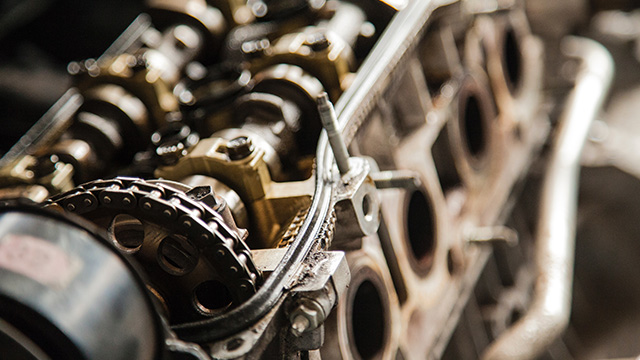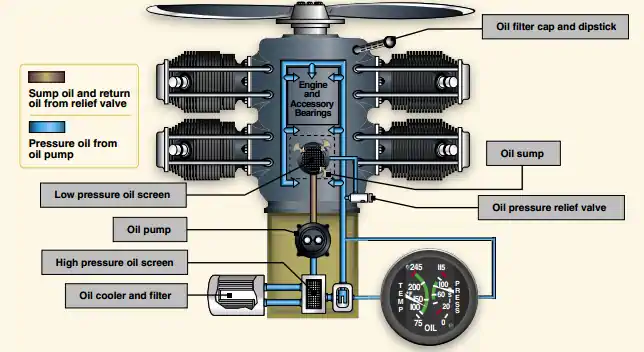
When charged with compressed air and the tanks valve is open pressurized oil is forced into the engine via a connection hose between the tank and engine block. Rather than waiting for oil pressure provided by the engines oil pump to circulate oil pressurizing the oil circuits before ever cranking the engine will ensure lubrication that will protect the bearings from damage during the first rotation of the crank.

In some cases the bearing manufacturer supplies the lube skid as.
How does oil circulate in an engine. In this short animation I briefly explain how the oil flows through an engine when its started after an oil changeoilenginehowitworksGarageTechcirculat. Answer 1 of 3. Oil circulation in an engine can vary depending on the size and type of engine On a medium size 2 stroke marine or locomotive engine oil is drawn from the sump by an electric or engine driven pump passed through a filter and cooler and into a pipeline in the engine called a head.
How does oil circulate in a car engine. If your car has pushrods rather than an overhead camshaft then oil is forced under pressure into the valve lifters. After lubricating the camshaft and the related components the oil flows by gravity back down channels in the head and motor block to the sump ready to begin another journey.
The camshaft operates at half engine speed but it needs effective lubrication because of the high rubbing loads on the camsIt is usual to pressure-feed the camshaft bearings and to splash or spray oil on the cam lobes. A push-rod engine with its camshaft mounted low in the crankcase has oil piped to the hollow rocker shaft from where it lubricates the rocker bearings and push-rod ends. Its forced circulation method for both cooling lubrication of the engine.
Oil water pumps are used for it which is driven by engine gear train or other method itself. Also having a specific coolant oil galleries for. To maintain the Engine temperature To avoid the frictional failure by lack of lubrication.
Most of the oil to the bearings leaks out the sides and back into the oil pan. Some stays its course and is routed to the cams or whatever where there is more leakage. Much is simply splashed lubed like the pistons and cam lobes.
So some oil is immediately returned to the sump and some makes it. When the engine is switched on it needs oil immediately. Oliver and his oil buddies get sucked up by the pickup tube and lined up for action.
The pump does the sucking so that Oliver can slide up that tube against gravity and then pressurizes the oil. Oliver and his little oil friends get jammed in together even closer. To let the engine warm up quickly the radiator is closed off by a thermostat usually sited above the pump.
The thermostat has a valve worked by a chamber filled with wax. When the engine warms up the wax melts expands and pushes the valve open allowing coolant to flow through the radiator. When the engine stops and cools the valve closes again.
How does oil circulate through an engine. The oil pump pulls the oil up from the sump bottom of the engine. This is where the oil is resting Once it gets pulled up it is then taken through the filter or cooler which cools the engine and then from there it is dispersed through the engine oil passages to lubricate pistons rings springs valve stems and so on.
Watch our new video on how to change your car engine oil in this video. An engine pre-oiler tank works on a very simple principle. The tank is designed as a simple pressure tank.
Oil is added to the tank reservoir. When charged with compressed air and the tanks valve is open pressurized oil is forced into the engine via a connection hose between the tank and engine block. Since at maximum flow the oil is circulating through an engine very quickly.
Conservatively speaking the volume of a typical 4 quart sump is pumped through an engine every 12 seconds. That provides little time for much heat transfer on a single pass or cycle. Im thinking maybe one degree.
Circulating oil systems or lube skids provide continuous flow of lubricant to bearings gearboxes and blowers. They lubricate machinery used to pump stormwater circulate fresh air into mines extract oil power ships manufacture paper and chemicals and test military equipment. In some cases the bearing manufacturer supplies the lube skid as.
The oil that ran down into the pan was headed there anyway. The oil necessary to protect the engine on startup was captured when you shut the engine off between the bearing and wear surfaces and by the honing in the cylinders. Unless of course the car has been sitting for a.
How long does it take for oil to circulate through an engine. Depending on your vehicles engine temperature it might vary from almost instantly to 3-second maximum. A cold engine usually takes more time than that of hot engines.
Does a car run better after. Rather than waiting for oil pressure provided by the engines oil pump to circulate oil pressurizing the oil circuits before ever cranking the engine will ensure lubrication that will protect the bearings from damage during the first rotation of the crank. This also holds true for even a previously run engine that may have sat dormant for.
The engine oil cooler circulates the oil through the pistons as the car engine is running then to tubes where heat is lost and back. Engine oil in an automotive lubricates helping to regulate the temperature of moving metallic portions of an engine or transmissions. The oil filter works to remove contaminants from engine oil extending the life of the engine and maintaining high oil quality which naturally degrades over time.
The oil pump sends used oil through a filter element removing the particles and allowing the oil to pass through. The freshly strained oil is then taken back up to the engine for. Engine oil reduces operating temperature and friction between components for better performance and longer life.
New lower oil pick-up points in Briggs Stratton engines have become and industry standard design. The lower pick-up point protects engines against.